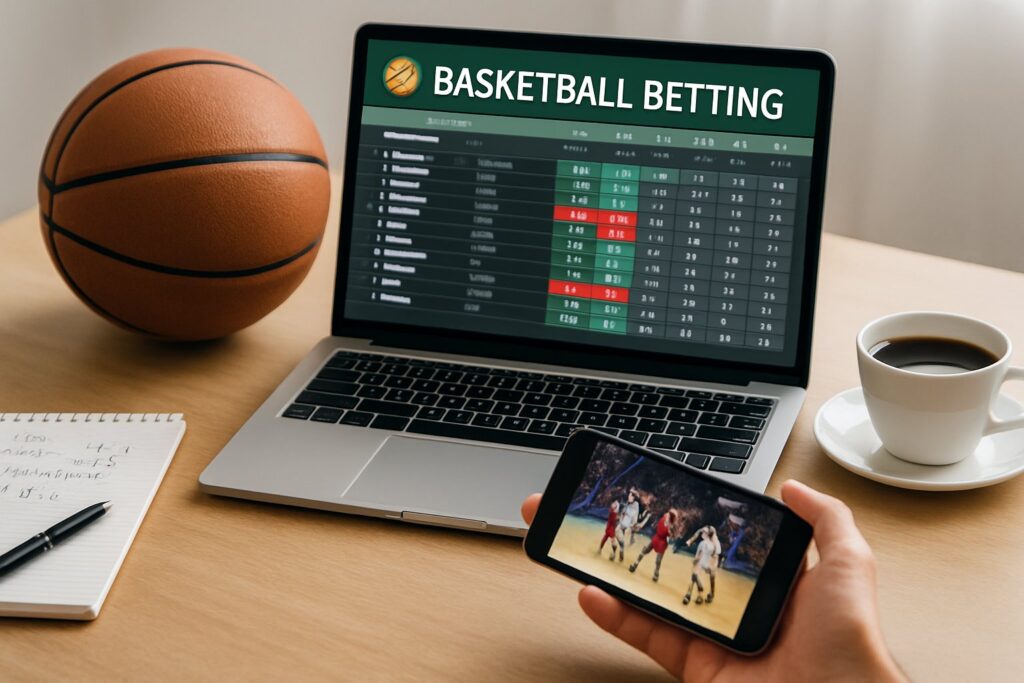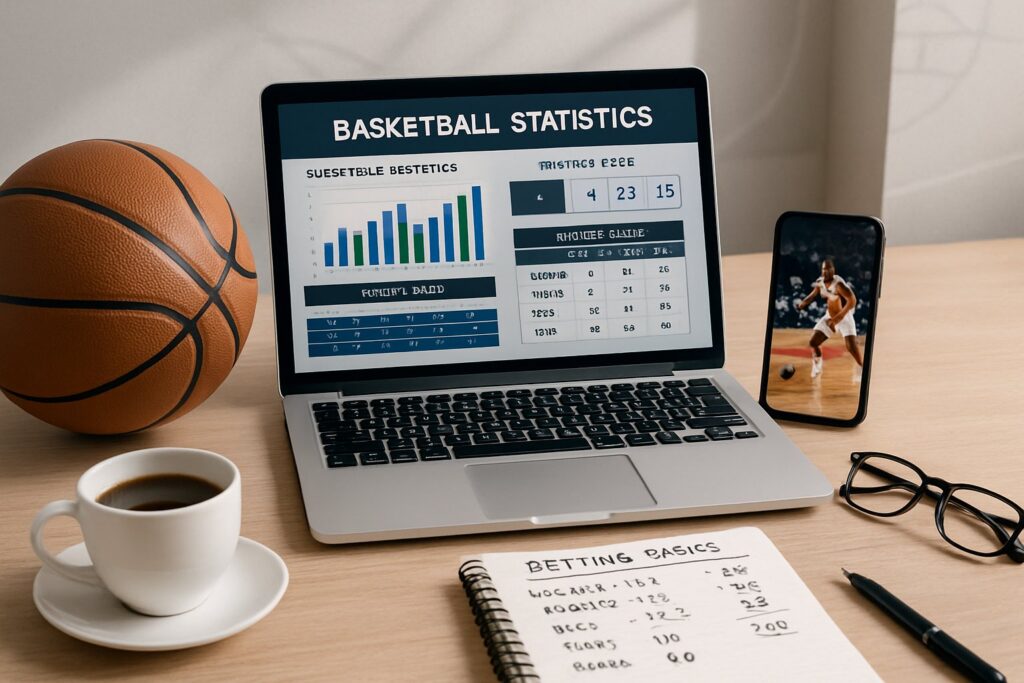by Martin Green
August 9, 2025
Last Updated on August 9, 2025 by Martin Green
Betting on basketball really starts with figuring out how the whole thing works and what your options look like. You make wagers by predicting things like which team will win, by how much, or what the total points will be. Once you get the basics down, you can actually make smarter bets instead of just throwing darts in the dark.

You can stick to common bets like moneylines, point spreads, and totals, or try props and live bets if you want more excitement. Each type has its own quirks and risks, so knowing when to use them can really help. Picking a trustworthy sportsbook and setting your own limits keeps things from getting out of hand.

When you bet on basketball, you’re putting money on a specific outcome in pro or college games. You make your picks based on odds set by bookmakers, who use stats and what the market is doing. If you want a shot at winning, you’ll need to know how bets work, what the terms mean, and how sportsbooks set their lines.
Sports betting, or sports wagering, is just risking money on the result of a sporting event. For basketball, that usually means picking the winner, the margin, or the total points scored.
You place your bet with a bookmaker (or sportsbook). They set the odds, which decide your payout. Odds reflect how likely something is and include the bookmaker’s cut.
Let’s say a team is a big favorite. The payout shrinks because it’s less risky. If you pick the underdog, you get a bigger payout since it’s a long shot.
You can bet before tip-off or during the game. Live betting lets you react to what’s happening in real time, but be ready – the odds shift fast.
Learning the language helps you avoid rookie mistakes.
Some of the basics:
Here’s a quick example: If Team A’s spread is -5.5, they need to win by 6 or more for your bet to cash. If they win by 5 or lose, you’re out.
Bookmakers use stats, team data, and betting trends to set their odds. They want to balance the action on both sides of a bet.
Their profit comes from the vig or juice. That’s why, for example, you might see both teams at -110. You’d have to risk $110 to win $100, and that extra $10 goes to the bookie.
Bookmakers shift odds if there are injuries, lineup changes, or a flood of bets on one side. If too much money comes in on one team, they’ll move the line to even things out.

Most basketball bets focus on who wins, by how much, or what the total score will be. Each type of wager has its own rules and odds, which changes how you decide where to put your money. If you know the differences, you can pick what fits your style best.
Point spread betting tries to level the playing field between a favorite and an underdog. The sportsbook gives the favorite a points handicap, and they need to win by more than that to “cover” the spread.
For example, if the Lakers are -7.5, they have to win by 8 or more for your bet to hit. If the Bulls are +7.5, and they lose by 7 or fewer (or win), a bet on them pays out.
This is called betting against the spread (ATS). The odds are usually -110, so you risk $110 to win $100. Odds can move if there are injuries, weird matchups, or heavy betting one way or the other.
Moneyline bets are as simple as it gets. Just pick who wins, no need to worry about the score difference.
Favorites have negative odds, like -200, so you’d have to bet $200 to win $100. Underdogs get positive odds, like +180, so a $100 bet wins you $180 if they pull off the upset.
Here’s a quick reference:
| Odds Type | Example | Meaning |
|---|---|---|
| Favorite | -150 | Bet $150 to win $100 |
| Underdog | +200 | Bet $100 to win $200 |
Moneyline bets make sense if you’re sure about the winner but not the margin. They’re also good for games with a tight spread or if you want to take a shot on a big underdog.
Totals bets are all about the combined score. The book sets a number, and you pick if the real total will go over or under that line.
Say the total is 215.5. If the teams combine for 216 or more, OVER wins. If it’s 215 or less, UNDER wins.
This bet doesn’t care who wins. It’s about pace, playing style, and defense. Fast teams usually mean higher totals, while defensive battles drag the number down.
You can also bet totals for halves, quarters, or just one team’s points. There’s a lot of flexibility here, which is nice.
Where you place your bets makes a difference in odds, bet types, and how you handle your money. The rules and features can vary a lot, so take some time to compare before you jump in.
First, check for licensing and regulation. Legal sportsbooks follow state or national laws, which helps protect your money and info.
Compare odds and lines at different sportsbooks. Even a half-point or a few bucks difference can add up over time.
Look at betting markets. Some books focus on NBA games, while others cover college hoops, overseas leagues, and player props.
Review payment methods. You want easy deposits and withdrawals, whether that’s bank transfers, debit cards, or e-wallets.
Check limits for minimum and maximum bets. This matters if you like to bet small or want to go big.
And honestly, test the user experience. A clunky site is just a pain. You’ll want something fast, clear, and reliable on your phone too.
Online sportsbooks let you bet from your phone or computer.
Usually, you’ll get:
They update odds quickly and make account management easy, but you’ll need internet and to verify your account.
Local bookmakers operate in person, maybe at a casino or betting shop.
They offer:
But they usually have fewer markets and less competitive odds than the big online books.
Some folks use both, just to get the best odds or features from each.
If you want to bet basketball well, you’ll need to actually look at real game data, player impact, and how the market is moving. Stats matter, but so does knowing what’s going on with lineups and how betting lines shift before the game.
Start with recent team form. Check the last 5-10 games, but also look at who they played. For example, if the Milwaukee Bucks beat up on playoff teams, that means more than wins over bottom-feeders.
Home and away splits matter too. The Indiana Pacers might be tough at home, while the Brooklyn Nets could surprise on the road. These things can change the spread or total.
Individual player performance is huge. If Stephen Curry is on a hot streak from three, the Warriors’ scoring goes up. Look at matchups too – is a star up against a bad defender or a lockdown guy?
Some key stats to track:
| Category | Why It Matters |
|---|---|
| FG% / 3P% | Shooting efficiency |
| Rebounds | Controls possessions |
| Turnovers | Gives the other team extra chances |
| Pace | Impacts total points |
Injuries can flip a game in a hurry. If the Lakers lose a top starter, their offense or defense might fall apart. Always check the injury report before you bet.
Roster depth matters too. The Clippers can survive an injury better than a team with a short bench.
Watch for load management in the NBA. Star players sometimes sit out back-to-backs, even if they’re healthy, especially late in the season when playoff spots are locked up.
Tracking starting lineups close to game time helps you avoid betting on a team missing key guys. Even one missing player can change everything, especially if the rotation is tight.
Odds show what the stats say and how people are betting. If the Bucks open as -5 favorites but move to -7, that usually means a lot of money has landed on Milwaukee.
Injury news, betting trends, or sharp bettors can move the line. You might want to bet early or wait, depending on how you see the situation playing out.
Watch those public betting percentages. If most bets are piling up on the Lakers but the line shifts toward their opponent, that could mean the pros are backing the other side.
Always check odds at several sportsbooks. Even a tiny difference in point spread or moneyline price can add up over time.
Figure out what you can afford to lose and set limits before you make any bets. Having clear boundaries and realistic targets keeps you from making reckless choices and helps your betting last longer.
Your bankroll is the money you set aside just for betting. Only use money you’re willing to lose—don’t touch the rent or savings.
Keep your betting cash separate. A dedicated account or e-wallet makes it easier and stops you from mixing it with regular expenses.
Pick a unit size—the amount you’ll risk per bet. Most folks use 1% to 5% of their bankroll as a unit. For example:
| Bankroll | 1% Unit | 3% Unit | 5% Unit |
|---|---|---|---|
| $500 | $5 | $15 | $25 |
| $1,000 | $10 | $30 | $50 |
Sticking with a set unit size helps you survive losing streaks. Don’t chase losses by suddenly bumping up your bets.
If your bankroll changes a lot, adjust your unit size to keep your risk steady.
Set goals that focus on steady growth, not trying to double your money overnight. Maybe aim to grow your bankroll by a few percent in a month instead of swinging for the fences.
Track your bets in a basic spreadsheet. Jot down the date, teams, wager, odds, and result. Looking back at this helps you spot patterns and tweak your strategy.
Even with solid research, losing streaks will happen. Focus on making smart bets and protecting your bankroll, not trying to win every time.
Don’t worry about how others are doing. Your results come down to your discipline, research, and how much risk you’re comfortable with—not someone else’s stats.
Basketball betting value is often about small percentage edges that slowly add up. You can boost your results by paying attention to the price you pay and cutting out hidden costs in the odds.
Sportsbooks usually post slightly different odds for the same game. Line shopping means you pick the best number or price you can find.
Let’s say you want to bet a team at -4.5 points. One book lists -110, another -105. Over time, those little differences save you real money.
Open accounts at a few sportsbooks so you can compare lines before betting. Odds comparison tools online make this quicker and help you spot value fast.
Even a half-point difference can turn a loss into a push or a push into a win, especially since basketball games often come down to tight margins.
The vig (or juice) is the fee the sportsbook charges to take your bet. Standard odds like -110 mean you risk $110 to win $100—the $10 is the vig.
Lower vig means you keep more of your winnings. Some books offer reduced juice lines, like -105, especially in promos or for high-volume players.
Cut the juice by shopping around, betting during quieter times, or targeting markets where the bookmaker’s margin is lower.
Here’s a quick example:
| Odds | Risk to Win $100 | Vig Paid |
|---|---|---|
| -110 | $110 | $10 |
| -105 | $105 | $5 |
Cutting the vig in half can make a real difference in your long-term results.
To succeed at basketball betting, you need to get how odds work, know how player and team performance matter, and use data to guide your picks. Managing risk is just as important, especially if you’re betting live or over a long season.
Check recent team form, injury reports, and head-to-head matchups.
Think about how each team plays at home versus on the road.
Look at pace and scoring efficiency – those can swing spreads and totals.
The point spread levels the playing field by giving the underdog points or taking them from the favorite.
If you pick the favorite, they need to win by more than the spread.
If you pick the underdog, they can lose by fewer points than the spread or just win outright.
An over/under bet is about the total points in a game.
You decide if the real total will go over or under the number set by the sportsbook.
It’s about scoring pace and efficiency, not who wins.
Track your bets and review your results to spot what’s working and what’s not.
Stick to markets you know, like spreads or player props.
Don’t chase losses, and always set a budget to protect your bankroll.
Go beyond basic stats like points per game.
Look at things like offensive rating, defensive rating, rebound rate, and turnover percentage.
Compare these over recent games to spot trends that might impact the outcome.
Live betting lets you react to in-game events, like sudden injuries or momentum shifts.
You might find value if you notice changes before the odds catch up.
But making snap decisions under pressure can easily lead to mistakes or bad calls.